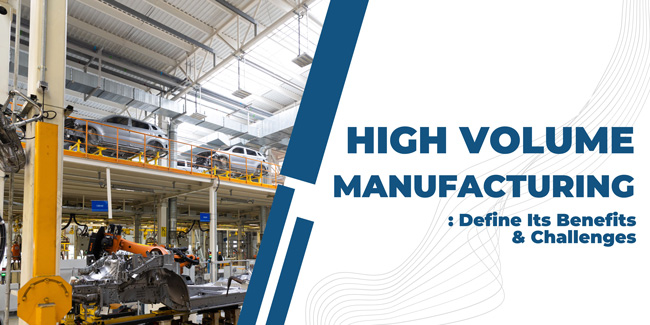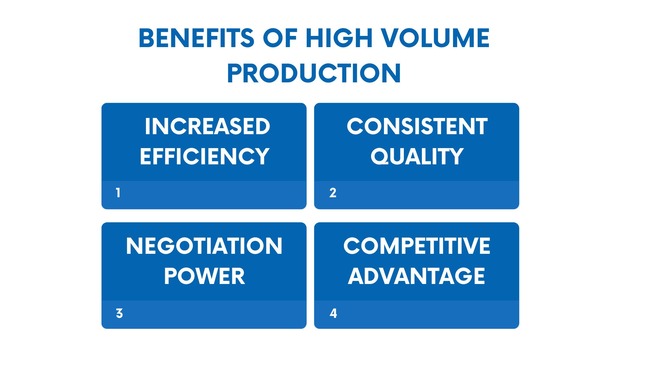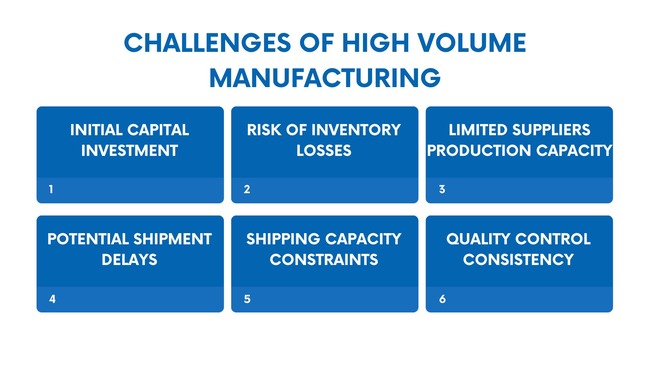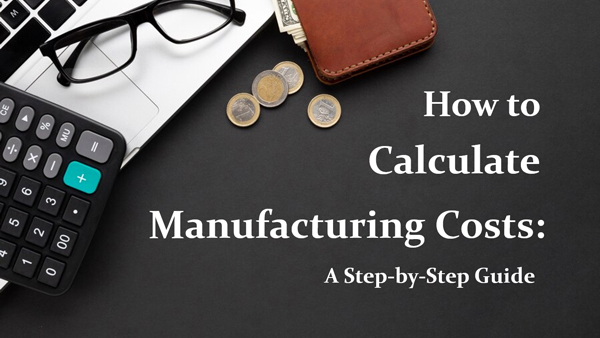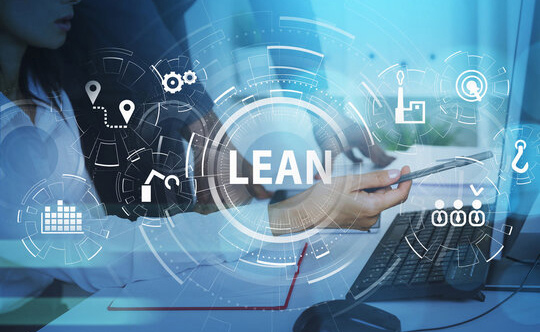High Volume Manufacturing: Define Its Benefits & Challenges
- Date:
- Author: SVI Content Team
- Share:
To make products, companies have different options to suit different needs. At the forefront of options stands high volume manufacturing—a way great for established enterprises with substantial demands to meet. Conversely, low-volume manufacturing emerges as a choice for new products or smaller companies cautiously navigating market waters.
High volume production is to fabricate large quantities of goods within short periods of time. It offers certain advantages. Nonetheless, as with any approach, high-volume production comes with its own set of challenges. Before you jump into high volume manufacturing, it’s important to know what you’re getting into. Let’s discuss its good parts and tricky bits, so you can decide what’s best for your business.
Part 1. Benefits of High Volume Production
Ever wonder why companies opt to churn out a large volume of products? Well, let’s take a look at what are the advantages of high volume production.
1. Increased Efficiency
High volume manufacturing processes are often finely tuned for efficiency. With standardized work procedures and workers assigned to specific tasks, the production line operates like a well-oiled machine. Assisted by automated equipment, products can be manufactured at a rapid pace. It results in shorter lead times for manufacturing.
For businesses sourcing overseas, this means faster turnaround times, reduced order processing times, and a quicker time-to-market for their products. It enables them to stay ahead of competitors and capitalize on market opportunities.
2. Consistent Quality
One of the benefits of mass manufacturing is that it ensures a solid foundation of quality ensured by machinery. By minimizing manual labor, machines reduce the chances of errors creeping into the production process. Moreover, manufacturers with robust quality control measures in place can guarantee that products meet the required specifications and regulatory standards.
3. Strong Negotiation Power
Companies ordering large production quantities wield strong negotiating power when it comes to pricing and payment terms. Since manufacturers often sweeten the deal with discounted pricing for bulk orders, importers have the opportunity to obtain the desired price through negotiation. Moreover, large-volume production allows importers to take advantage of economies of scale, which drives down per-unit production costs. This allows for maximizing profit margins and remaining competitive.
4. Competitive Advantage
Securing the ideal price for your products can provide a significant competitive edge. Lower production costs allow importers to offer more attractive pricing to their customers. The competitive pricing not only appeals to a broader customer base but also drives increased sales volumes, ultimately allowing businesses to capture a larger share of the market. This in turn makes the business an outstanding one.
Part 2. Challenges of High Volume Manufacturing
Yes, it is undeniable that mass production is favorable to efficiency, and pricing. But, under the changing global landscape, organizations are increasingly drawn to the agility and adaptability offered by smaller-quantity manufacturing. Why the shift? There are challenges that persist within high volume manufacturing.
1. Initial Capital Investment
Embarking on high volume manufacturing demands a substantial upfront capital investment. Beyond just the cost of goods, companies must factor in expenses such as logistics, shipping, tariffs, and exchange rates. The initial financial outlay can be daunting.
Businesses must carefully assess their capital resources, explore financing options, and develop comprehensive budgeting strategies to fund the required investments effectively. Crucially, negotiating competitive pricing and optimizing logistics and shipping costs are vital strategies to uphold profitability.
2. Risk of Inventory Losses
High volume manufacturing entails a time-intensive process, from production to transportation and distribution. This extended timeline poses challenges for companies aiming to stay aligned with market trends. As products traverse from development to distribution, the dynamic landscape of market trends, customer preferences, and competitive dynamics constantly evolves.
Excessive inventory not only incurs additional warehousing costs but also poses the potential for inventory obsolescence or markdowns. Therefore, importers should closely monitor market trends and carefully manage inventory levels to avoid carrying an excess inventory of products.
3. Limited Production Capacity of Suppliers
Suppliers often serve multiple clients concurrently, a reality that can result in situations where the supplier’s production capacity is stretched thin or bottlenecked. In such scenarios, the company synchronize its production schedule with that of the supplier, often necessitating a wait for the completion of prior orders. Waiting can impose constraints on production timelines and potential delays in the production process.
Sourcing companies should access the production capacity before collaborating closely with manufacturers, and should also plan production schedules in advance and discover diversified production options to ensure timely fulfilment of orders.
4. Potential Shipment Delays
Shipping high volume production often faces difficulties. On a large scale, transportation usually demands a lot of manpower and material resources. Moreover, it is susceptible to uncertainties such as congestion at ports, transportation bottlenecks, and adverse weather conditions which can impact delivery schedules. Having precise calculations and planning, and monitoring shipping routes can safeguard against potential shipment delays and ensure the safe and timely delivery of products to the destination.
5. Capacity Constraints in Shipping During Peak Seasons
Shipping during peak seasons, such as holidays or promotional periods, the logistics companies may have strained transportation networks. The resulting capacity constraints not only translate into delays in product delivery but also inflate freight rates, adding another layer of complexity. It is challenging to secure adequate shipping capacity for overseas clients. Only planning ahead, booking shipping capacity in advance and diversifying transportation can help you to navigate this challenge posed by shipping high volume manufacturing with resilience and agility.
6. Quality Control Consistency
Even though the quality of bulk production is more stable because it has less manual involvement. But maintaining consistent quality control across large volumes remains challenging. It requires establishing robust control measures, conducting regular quality control inspections and implementing quality assurance protocols. These can ensure products meet specifications and regulatory requirements, especially when dealing with overseas manufacturing.
Tackling the challenges of high-volume production can seem intimidating, but it doesn’t have to be a solo journey. Partnering with a seasoned sourcing professional is key to effectively overcoming these obstacles. SVI Global can bring valuable experience, industry insight and a network of trusted manufacturers. We can help your organization assess production capacity, negotiate beneficial terms, and implement strong quality control measures. With our expertise, you are able to optimize production processes, reduce risk and unlock the full potential of high-volume production.
Part 3. FAQs of High Volume Manufacturing
There are questions that you might like to fathom the answers when you search them. Discover the following questions to solve your doubts.
Q1. What Would be Considered High Volume Production?
What is high volume manufacturing? In essence, it involves producing a considerable quantity of goods in a relatively short period.
There is no fixed quantity that universally defines a high volume. It typically refers to production volumes that are significantly beyond the average or standard production level within a given context. The quantity of manufacturing can range from thousands to millions of units, and vary widely across industries.
For example, in the automotive industry, high volume production may involve producing hundreds of thousands or millions of vehicles annually, whereas, in the electronics industry, high volumes can involve producing millions or even billions of units of components or devices.
Q2. Is High Volume Better than Low Volume Production?
There is no one better, only the right one. Choosing the strategy that aligns with your unique circumstances and objectives.
As we know mass production indeed offers efficiency, competitive pricing, and quality advantages. Yet, no garden without weeds. It’s not without its challenges, such as the risk of inventory loss and shipping delays. On the other hand, the challenges of low volume sourcing may seem to have less negotiating power and efficiency, along with quality control challenges. However, it brings its own benefits like flexibility, lower inventory risk, and potentially favorable cost-benefit ratios.
If you’re aiming to maximize cost savings and swiftly meet market demand, manufacturing products with identical features in high volumes may be the optimal route. Ultimately, the decision between high volume and low volume production hinges on various factors such as your business needs, market demand, production capabilities, and cost considerations.
Part 4. Conclusion
High volume manufacturing is to mass produce a product. It presents both opportunities and challenges for companies seeking to optimize their production processes and gain a competitive edge in the market. The advantages of high volume production, including cost efficiency, competitive pricing, and consistent quality, offer procurement staff the potential for increased profitability and market share expansion. However, hurdles such as initial capital investment, inventory risk, shipping problems, and quality control consistency lurk in the process and cannot be neglected.
The decision to invest in mass production should not be taken lightly. One must consider all factors, weighing the pros and cons of high-volume manufacturing against their specific business needs before investing in mass production.
If you want to make your manufacturing run smoothly, try and cooperate with a sourcing company that offers comprehensive solutions. SVI Global is what you can rely on. We will help you achieve your goals by addressing the challenges of high volume and ensuring you get the best price and on-time delivery of products. Take the next step towards success and let SVI Global be your guiding light through the complexities of high volume manufacturing.

